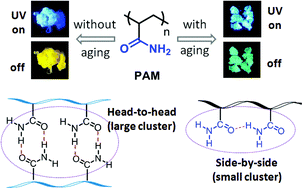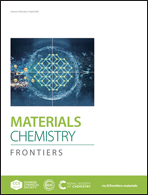Regulation of clusterization-triggered phosphorescence from a non-conjugated amorphous polymer: a platform for colorful afterglow†
Abstract
Recently unorthodox organic luminescent materials termed as clusteroluminogens, have evoked increasing attention due to their facile preparation, good hydrophilicity and biocompatibility, and environment-friendliness. However, it is still a big challenge to acquire clusterization-triggered phosphorescence (CTP) in air, especially afterglow with lifetime longer than 0.1 s, due to lack of effective control means. Herein, a simple method is presented to realize ultralong and colorful CTP of polyacrylamides (PAMs) by changing the polymeric conditions. It is found that PAMs initiated by water-soluble initiators show relatively high molecular weight and strong persistent CTP, and that the color of CTP can be altered by changing the polymerization temperature. Experimental and theoretical calculation results indicate that the colorful afterglow of PAMs depends on the size of cluster formed through intra- and intermolecular hydrogen bonding (HB). Interestingly, the PAMs can be employed as a platform to yield afterglow with wide emission wavelength from 466 nm to 616 nm, and long lifetime up to 1.7 s by blending or copolymerizing with different luminophores, even to give a visible-light-excited CTP. Due to the reversibility of HB, an afterglow switching based on PAM derivatives in films can be realized by changing the external stimuli.



 Please wait while we load your content...
Please wait while we load your content...